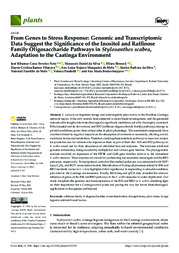From genes to stress response: genomic and transcriptomic data suggest the significance of the inositol and raffinose family oligosaccharide pathways in Stylosanthes scabra, adaptation to the Caatinga environment.
From genes to stress response: genomic and transcriptomic data suggest the significance of the inositol and raffinose family oligosaccharide pathways in Stylosanthes scabra, adaptation to the Caatinga environment.
Author(s): FERREIRA NETO, J. R.; SILVA, M. D. da; BINNECK, E.; VILANOVA, E. C. R.; MELO, A. L. R. M. de; SILVA, J. B. da; MELO, N. F. de; PANDOLFI, V.; BENKO-ISEPPON, A. M,
Summary: S. scabra is an important forage and extremophilic plant native to the Brazilian Caatinga semiarid region. It has only recently been subjected to omics-based investigations, and the generated datasets offer insights into biotechnologically significant candidates yet to be thoroughly examined. INSs (inositol and its derivatives) and RFO (raffinose oligosaccharide family) pathways emerge as pivotal candidates, given their critical roles in plant physiology. The mentioned compounds have also been linked to negative impacts on the absorption of nutrients in mammals, affecting overall nutritional intake and metabolism. Therefore, studying these metabolic pathways is important not just for plants but also for animals who depend on them as part of their diet. INS and RFO pathways in S. scabra stood out for their abundance of identified loci and enzymes. The enzymes exhibited genomic redundancy, being encoded by multiple loci and various gene families. The phylogenomic analysis unveiled an expansion of the PIP5K and GolS gene families relative to the immediate S. scabra ancestor. These enzymes are crucial for synthesizing key secondary messengers and the RFO precursor, respectively. Transcriptional control of the studied pathways was associated with DOFtype, C2H2 , and BCP1 transcription factors. Identification of biological processes related to INS and RFO metabolic routes in S. scabra highlighted their significance in responding to stressful conditions prevalent in the Caatinga environment. Finally, RNA-Seq and qPCR data revealed the relevant influence of genes of the INS and RFO pathways in the S. scabra response to water deprivation. Our study deciphers the genetics and transcriptomics of the INS and RFO in S. scabra, shedding light on their importance for a Caatinga-native plant and paving the way for future biotechnological applications in this species and beyon
Publication year: 2024
Types of publication: Journal article
Unit: Embrapa Soybean
Observation
Some of Embrapa's publications are published as ePub files. To read them, use or download one of the following free software options to your computer or mobile device. Android: Google Play Books; IOS: iBooks; Windows and Linux: Calibre.
Access other publications
Access the Agricultural Research Database (BDPA) to consult Embrapa's full library collection and records.
Visit Embrapa Bookstore to purchase books and other publications sold by Embrapa.

